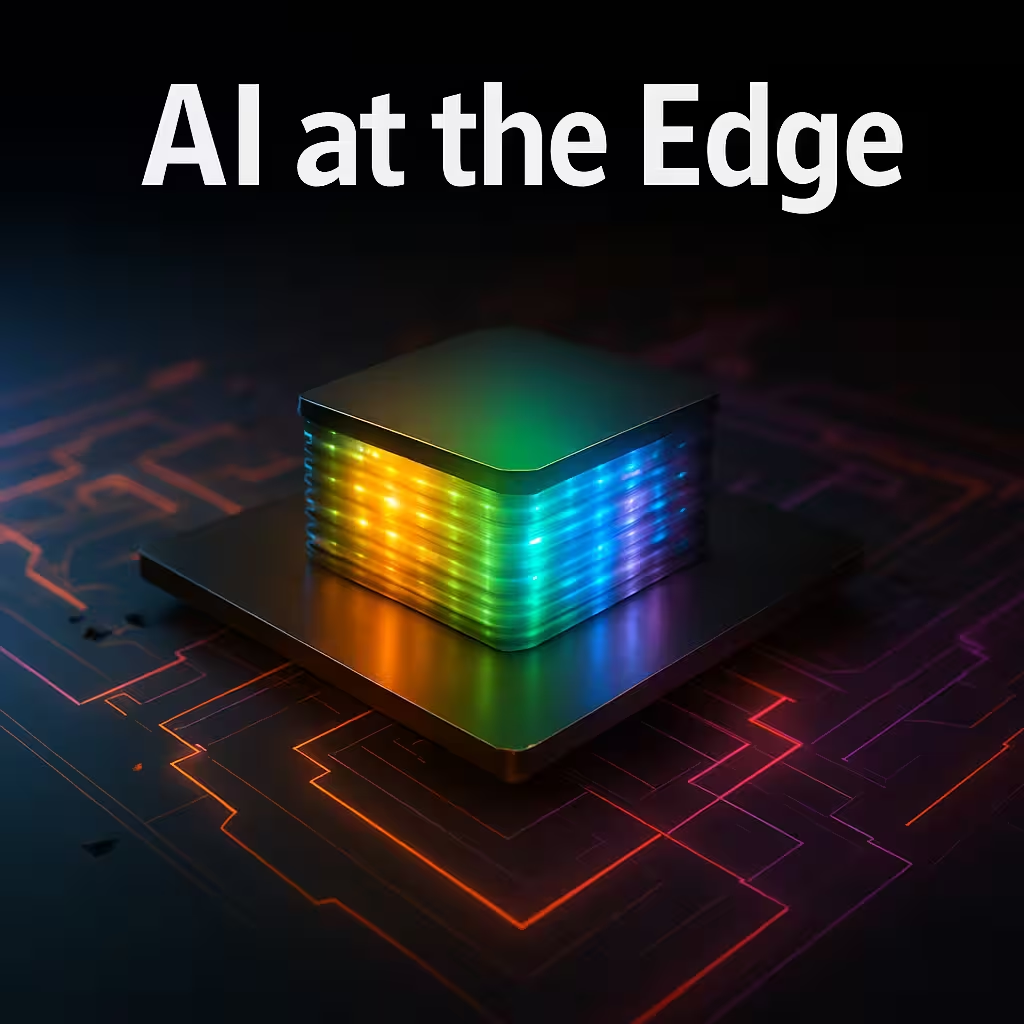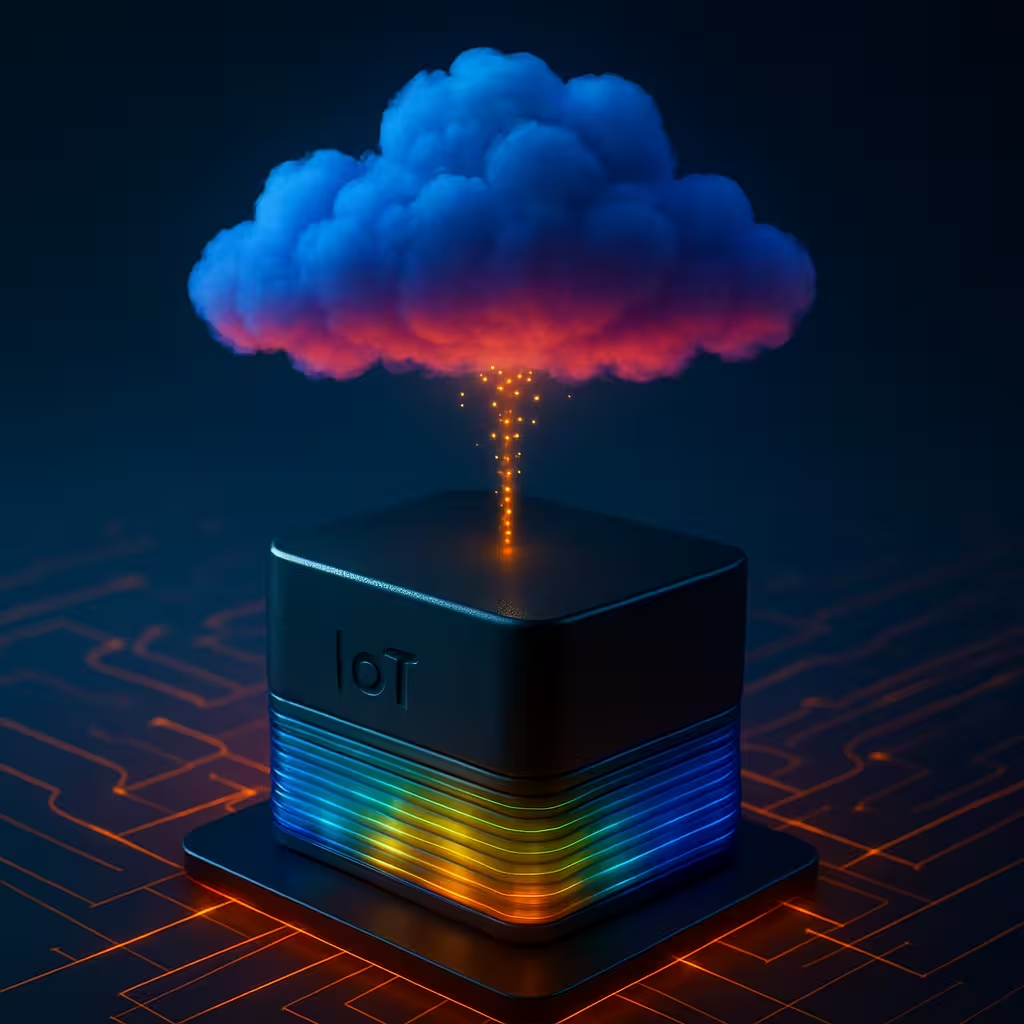The Future of IoT AI in 2025 and Beyond

Machine learning (ML) has become a cornerstone of smart, autonomous decision-making in IoT devices. These “smart devices” derive their intelligence from the ability to analyze and act quickly on sensor data, at the edge, and respond accordingly.
Historically, microcontrollers were too limited for anything beyond basic rule-based logic. But with the advent of frameworks like TensorFlow Lite for Microcontrollers, we entered the era of TinyML, enabling machine learning on even the most resource-constrained devices.
Edge AI Meets Cloud: The Rise of Hybrid IoT AI
While device-based models have steadily benefited from better microcontrollers and model optimization techniques, the AI landscape has seen an explosive leap in cloud model capabilities in the past year. Foundation models such as OpenAI’s GPT-4, Anthropic’s Claude, and Google’s Gemini are now so advanced they can understand, generate, and reason across multiple modalities—text, speech, image, and sensor data.
These models are now capable of powering use cases that were literally unthinkable just a couple of years ago. As these cloud models continue to evolve, the boundary between edge and cloud capabilities is rapidly shifting.
This changes the game for edge AI. Rather than a simple migration from cloud to edge, we’re now seeing a hybrid IoT AI architecture emerge. Edge devices handle real-time, low-power inference, while the cloud provides deep reasoning, personalization, and large-scale pattern recognition.
Edge AI is still essential — especially for real-time, low-latency, or privacy-focused applications. But as cloud AI grows exponentially in power and flexibility, hybrid architectures that combine edge inference with cloud intelligence are becoming the new standard.
IoT AI no longer means all inference happens on the device.
A modern IoT device might use edge ML to locally detect a wake word, capture sensor anomalies, or manage immediate control loops — and then stream relevant data to a cloud model for deeper analysis, anomaly detection, or personalized insights. This hybrid model unlocks the best of both worlds: instant local reactions and the nearly limitless compute of the cloud.
This paradigm shift doesn’t mean edge ML is obsolete — far from it. But the growing capability of cloud AI means edge models don’t need to carry the full burden of intelligence. Instead, edge devices are evolving into smart front-ends that delegate deeper reasoning and processing to the cloud.
New Possibilities
This unlocks new possibilities for IoT AI applications:
- On-demand intelligence: Devices can dynamically invoke cloud AI only when needed — for example, to send a low-res image for anomaly classification or trigger a cloud-based automation workflow.
- Context-aware edge devices: A smart home assistant can locally detect movement, then query a cloud model to determine whether it’s a pet, an intruder, or a family member—using household context and historical behavior.
- Edge-tuned cloud services: Platforms like EmbedThis Ioto offer APIs that let devices feed structured sensor data to cloud models, such as custom GPTs fine-tuned for your factory floor.
Cloud models can do things today we couldn’t imagine last year
IoT Platforms like EmbedThis Ioto are now integrating direct IoT AI APIs to cloud models alongside the ability to run local inference.
Why Run ML on Microcontrollers?
Machine learning is still important for IoT devices. Everyday electronics can become “smarter” by directly integrating ML models into microcontrollers. This means they can function without relying on an external processor or constant cloud access for tasks like signal processing, speech recognition, scene recognition, predictive maintenance, or anomaly detection.
Running ML models directly on microcontrollers enables:
- Real-time processing with minimal latency
- Energy efficiency, vital for battery-powered or low-power devices
- Improved privacy and security by keeping data local
- Device Autonomy for remote, disconnected or bandwidth-constrained environments
We must now consider what AI tasks should run locally and what should run in the cloud.
As microcontrollers continue to improve in capability — with better DSPs, more onboard RAM, and built-in AI accelerators — they can support increasingly sophisticated models. However, developers must now think not just about what can run locally, but what should run locally versus in the cloud. For instance, basic anomaly detection may happen at the edge, while complex root-cause analysis is handled in the cloud by large foundation models.
The Role of Cloud Models

Despite the rapid evolution of edge hardware, some AI tasks are too large, complex, or data-hungry to run efficiently on embedded hardware. While edge devices excel at fast, local decision-making, there’s a growing class of applications that benefit from offloading high-level inference and reasoning to the cloud.
Thanks to accessible cloud-based AI APIs and low-latency connectivity, edge devices can invoke powerful foundation models on demand—tapping into capabilities like natural language processing, multimodal and deep reasoning.
This enables a flexible, dynamic collaboration between edge and cloud. For example:
- A low-powered environmental sensor can summarize temperature trends locally, then call a cloud model to predict equipment failure based on similar historical patterns.
- A logistics scanner might capture visual damage indicators and request cloud-based assistance to classify the severity and recommend next steps.
- A medical wearable can track biometric data in real time, but push anomalies to a cloud model trained on population-scale datasets for further analysis and multilingual patient feedback.
These scenarios are no longer experimental. Enterprises and device makers are deploying them today—using model APIs from a growing ecosystem of providers. Whether leveraging large language models, vision transformers, or speech models, the goal is the same: push only what’s needed to the cloud, and only when it adds value.
Even on the device itself, we’re beginning to see tiny variants of large models—quantized, distilled, or pruned—running directly on AI-capable microcontrollers and edge SoCs. This allows for partial inference locally, followed by cloud-based reasoning. For example:
- A compact vision model might detect movement on-device, while a cloud model interprets the activity to identify species under threat.
- A quantized NLP model might perform wake-word detection or intent classification at the edge, with complex dialogue managed in the cloud.
The takeaway? Cloud-based large models aren’t replacing edge ML—they’re augmenting it. As hardware and software evolve, we’re moving toward a more nuanced AI stack where tasks are dynamically split between device and cloud depending on compute needs, latency requirements, and context.
When to Use Edge vs. Cloud AI
| Item | Edge | Cloud |
|---|---|---|
| Latency | Ultra-low (ms) | Higher, network-dependent |
| Privacy | High – data kept local | Depends on cloud platform |
| Model Size | Tiny (KB–MB) | Massive (GBs–TBs) |
| Scalability | Limited by device resources | Unlimited by cloud resources |
| Power Usage | Low | High |
| Use Cases | Real-time reaction, offline ops | Contextual reasoning, NLP, Pattern recognition |
| Best For | Safety-critical, mobile, wearable | Deep analytics, multimodal tasks |
The future is not about choosing edge or cloud—it’s about orchestrating the best of both.
How to Invoke Cloud Models
Edge devices can invoke cloud AI in multiple ways:
- Direct Call: Use REST API or WebSocket to call the cloud model and get a response.
- Agentic Workflow: The device agent provides a suite of tools (functions) that can be invoked by the cloud model (indirectly) as responses are received and processed by the device.
- Automated Trigger: Device sensor data posted by the device to the cloud triggers IoT platform automations that then invoke the cloud model with the device data and return the result to the device.
What IoT AI Really Means for 2025
While machine learning on microcontrollers has become more capable, the real story of 2025 is the rise of collaborative intelligence between edge and cloud. Edge ML frameworks like TensorFlow Lite continue to evolve — but they now sit within a broader AI ecosystem powered by powerful cloud models.
For developers, this means new design choices and new tradeoffs. You no longer need to cram every ounce of intelligence into a tiny microcontroller. Instead, you can architect your system to act fast at the edge, think deep in the cloud, and unlock IoT AI experiences previously out of reach.
EmbedThis Ioto

EmbedThis Ioto is a modern IoT Meta-platform designed to simplify the deployment of IoT AI-powered, connected devices. At its core is a compact, high-performance device agent that bridges edge intelligence with cloud-scale AI—enabling smart devices to both run local machine learning models and invoke powerful foundation models via direct cloud APIs.
With Ioto, edge devices can:
- Run TinyML inference locally in parallel with other device operations.
- Call cloud-based foundation models for tasks that require deeper reasoning, analysis, large language processing, or multimodal understanding.
- Run agentic workflows locally using local agents and cloud-based models triggered by device data events or cloud-based automations.
- Seamlessly sync data and state between the device and cloud with built-in MQTT, WebSockets, and RESTful HTTP support and then trigger cloud-based models and workflows based on device data events.
Cloud Model Integration
Ioto supports direct access to foundation model APIs, enabling devices to send structured data (e.g., sensor readings, text prompts, command requests) to the cloud and receive rich, contextual responses.
Ioto also supports invoking cloud models via automated triggers that monitor device data in the cloud and invoke models to analyze the data and generate responses and run workflows.
Ioto supports the following APIs:
- OpenAI Chat Completions API – for conversational AI and natural language processing
- OpenAI Response API – for generating structured outputs and invoking agentic workflows
- OpenAI Streaming API – for real-time interaction with minimal latency
- OpenAI Real-Time API – for continuous input/output workflows such as live monitoring or control
Although the default integration targets OpenAI, the API design is model-agnostic and compatible with any provider that supports the Chat Completions-style interface—including models from Anthropic, Mistral, Google, and open-source deployments using tools like OpenRouter or OpenLLM. It is anticipated that many other cloud providers will add support for the newer Responses API in the future.
Lightweight but Fully Equipped
Despite its small footprint—less than 300K of code—Ioto packs a comprehensive feature set:
- Embedded HTTP web server with TLS for secure local UIs and APIs.
- MQTT client and HTTP client for robust cloud connectivity.
- Built-in WebSockets support for real-time bi-directional communication.
- Embedded database and JSON parser for structured local data handling.
- Over-the-air (OTA) firmware updates.
- Tight integration with AWS services, including secure identity, storage, and messaging.
- Cloud LLM Integration for OpenAI, Anthropic, Mistral, and Google.
Together, these capabilities make Ioto a versatile platform for building hybrid IoT AI architectures. Developers can deploy lightweight models directly on-device for speed and privacy, while calling on large cloud models for deeper, contextual tasks—without needing to reinvent their stack or overburden their microcontroller.
Whether you’re building smart appliances, industrial sensors, or edge gateways, Ioto offers a future-proof foundation for IoT AI-enabled devices that think fast locally and think big in the cloud.
References
Consult the OpenAI documentation for API details:
{{comment.name}} said ...
{{comment.message}}